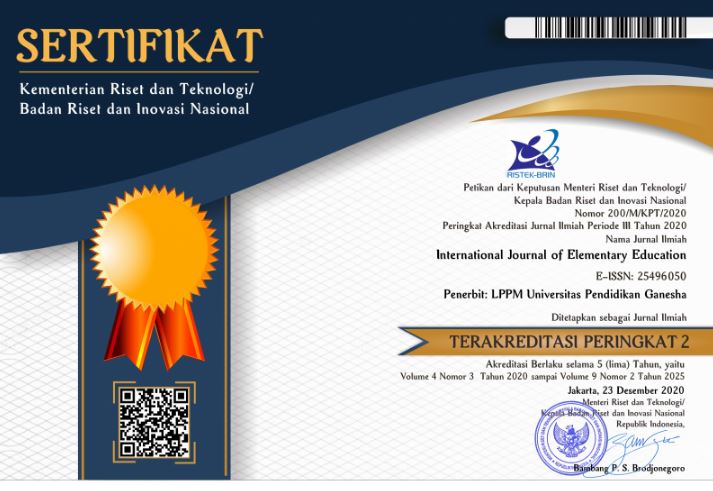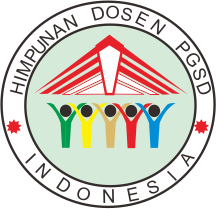Audio Visual Learning Media on Elementary School Students' Interest in Learning
DOI:
https://doi.org/10.23887/ijee.v8i3.78194Keywords:
Learning Media, Audio Visual, Learning InterestsAbstract
Learning media is a tool as an intermediary to facilitate classroom learning. The learning process using audio-visual learning media can make the learning process easier so that learning is more interesting and enjoyable. This research aims to analyze whether the application of audio-visual learning media to students' interest in learning in classes 5B and 5C can foster students' interest in learning. By using a quasi-experimental design and quantitative approach, this research is included in experimental research. The population in this study were all students in class 5B and 5C. Sampling in this study used a purposive sampling technique. The data collection method in this research is using a questionnaire, using and this research uses a Quasi experimental non-equivalent control group design or Quasi Experimental Design or usually called a quasi-experiment. The type of research used in this research is experimental research. Data analysis in this study used validity, normality and homogeneity tests as well as hypothesis testing which was carried out through the independent sample t-test. The research results show that the data has a normal and homogeneous distribution. There is a significant difference between the experimental class and the control class. Therefore, Ho is rejected and Ha is accepted. The average score in the experimental class was 61.22, while in the control class it was 58.46. Therefore, it can be concluded that audio-visual media has a significant influence on students' interest in learning.
References
Adam, A. (2023). Pengaruh Media Pembelajaran Audio Visual Terhadap Minat Belajar Siswa Sekolah Dasar. Journal of Contemporary Issue in Elementary Education (JCIEE), 1(1), 29–37. http://jurnal.ut.ac.id/index.php/jciee/article/view/5027.
Afriadi, S., Atmazaki, & Basri, I. (2021). The Effect of Inquiry Method Assisted by Audiovisual Media and Learning Motivation on Writing News Text Skills. Proceedings of the Ninth International Conference on Language and Arts (ICLA 2020), 539(Icla 2020), 227–231. https://doi.org/10.2991/assehr.k.210325.040.
Afriza, D. (2022). Comparison of The Learning Outcomes of Junior High School Students Utilizing Audio-Visual and Chart Learning Media to Study Ecosystem. Journal of Science and Technological Education, 1(1), 48–57. https://meta.amiin.or.id/index.php/meta/article/view/4.
Ahmad, S. Z. (2020). Cloud-Based Collaborative Writing to Develop EFL Students ’ Writing Quantity and Quality. International Education Studies, 13(3), 51–64. https://doi.org/10.5539/ies.v13n3p51.
Akçapınar, G., Er, E., & Bayazıt, A. (2024). Decoding Video Logs: Unveiling Student Engagement Patterns in Lecture Capture Videos. The International Review of Research in Open and Distributed Learning, 25(2), 94–113. https://doi.org/10.19173/irrodl.v25i2.7621.
Akhmad, I., Valianto, B., & Bowo, D. (2021). Interactive Media as Optimization of Understanding Basic Football Techniques in Pandemic Period. Proceedings of the 4th International Conference on Sports Sciences and Health (ICSSH 2020), 36(Icssh 2020), 66–69. https://doi.org/10.2991/ahsr.k.210707.017.
Akmalia, R., Fajriana, F., Rohantizani, R., Nufus, H., & Wulandari, W. (2021). Development of powtoon animation learning media in improving understanding of mathematical concept. Malikussaleh Journal of Mathematics Learning (MJML), 4(2), 105. https://doi.org/10.29103/mjml.v4i2.5710.
Andriyani, N. L., & Suniasih, N. W. (2021). Development of Learning Videos Based on Problem-Solving Characteristics of Animals and Their Habitats Contain in Ipa Subjects on 6th-Grade. Journal of Education Technology, 5(1), 37. https://doi.org/10.23887/jet.v5i1.32314.
Anjarwati, S., Darmayanti, R., & Khoirudin, M. (2023). Development of “Material Gaya” Teaching Materials Based on Creative Science Videos (CSV) for Class VIII Junior High School Students. Jurnal Edukasi Matematika Dan Sains), 11(1), 163–172. https://doi.org/10.25273/jems.v11i1.14347.
Antara, I. G. W. S., & Dewantara, K. A. K. (2022). E-Scrapbook: The Needs of HOTS Oriented Digital Learning Media in Elementary Schools. Journal for Lesson and Learning Studies, 5(1), 71–76. https://doi.org/10.23887/jlls.v5i1.48533.
Anwar, A. I., Zulkifli, A., Syafar, M., & Jafar, N. (2020). Effectiveness of counseling with cartoon animation audio-visual methods in increasing tooth brushing knowledge children ages 10–12 years. Enfermería Clínica, 30(2), 285–288. https://doi.org/10.1016/j.enfcli.2019.07.104.
Ardiana, E., & Ananda, A. (2022). The effect of using the tiktok application as a learning media on the activeness and learning. International Journal Of Social Science Education, Art and Culture, 1(2), 22–29. https://doi.org/https://doi.org/10.24036/langgam.v1i02.13.
As Sabiq, A. H. (2018). Improving Students’ Motivation and Reading Skills in Elt Through Audio Visual Media. Diksi, 25(1), 57–68. https://doi.org/10.21831/diksi.v25i1.16007.
Cendra, R., Gazali, N., & Dermawan, M. R. (2019). The effectiveness of audio visual learning media towards badminton basic technical skills. Jurnal SPORTIF : Jurnal Penelitian Pembelajaran, 5(1), 55. https://doi.org/10.29407/js_unpgri.v5i1.12757.
Desyandri, D., Muhammadi, M., Mansurdin, M., & Fahmi, R. (2019). Development of integrated thematic teaching material used discovery learning model in grade V elementary school. Jurnal Konseling Dan Pendidikan, 7(1), 16. https://doi.org/10.29210/129400.
Dewi, N. S., Parmiti, D. P., & Sukmana, A. I. W. I. Y. (2023). Media Video Animasi Pada Mata Pelajaran Pendidikan Agama Hindu dan Budi Pekerti. Jurnal Penelitian Dan Pengembangan Pendidikan, 7(2), 223–230. https://doi.org/10.23887/jppp.v7i2.60269.
Doyan, A., Susilawati, S., & Hardiyansyah, H. (2020). Development of Natural Science Learning Tools with Guided Inquiry Model Assisted by Real Media to Improve Students’ Scientific Creativity and Science Process Skills. Jurnal Penelitian Pendidikan IPA, 7(1), 15. https://doi.org/10.29303/jppipa.v7i1.485.
Dwinata, A., Yunita, E., Pratiwi, R., & Nuruddin, M. (2023). The Effectiveness Of Brainstorming Method And Audio- Visual Media On The Learning Outcomes Of Elementary School Ips Students. Jurnal Cakrawala Pendas, 9(1), 77–86. https://doi.org/10.31949/jcp.v9i1.3806.
Ellyana, A. C., & Tegeh, I. M. (2023). Problem-Based Learning-Based Learning Videos on Natural Science Content for Fifth Grade Elementary Schools. Jurnal Ilmiah Sekolah Dasar, 7(2), 327–335. https://doi.org/10.23887/jisd.v7i2.56769.
Ernayanti, S., Hadi, W., & Saragi, D. (2019). Feasibility of Audiovisual Media for Literacy Activities of Students of Grade V in Public Elementary School (SDN) 067241 Medan Denai. Budapest International Research and Critics in Linguistics and Education (BirLE) Journal, 2(2), 235–249. https://doi.org/10.33258/birle.v2i2.293.
Fikriyah, P. N., Kurniawati, D., & Dwi Merina, N. (2023). The The Effect of COVID-19 Vaccine Education with Audiovisual Media on Anxiety Levels of Pregnant Women as Candidates for COVID-19 Vaccination Participants. Nursing and Health Sciences Journal (NHSJ), 3(1), 67–73. https://doi.org/10.53713/nhs.v3i1.171
Hardiyansyah, M. R., Sumantri, P., Nugraha, M. A., & ... (2023). Utilization of Audio Visual as a Learning Resource for History Subjects at SMA Mulia Pratama Case Study in Class X. JIM: Jurnal Ilmiah …, 8(3). https://doi.org/https://doi.org/10.24815/jimps.v8i3.26330.
Indrawari, C. D. S., Ninghardjanti, P., Wirawan, A. W., & Dirgatama, C. H. A. (2020). Archiving learning video design in vocational high school. Journal of Physics: Conference Series, 1446(1). https://doi.org/10.1088/1742-6596/1446/1/012064.
Indrawati, C. D. S., Ninghardjanti, P., Dirgatama, C. H. A., & Wirawan, A. W. (2022). The effect of practicum learning based audiovisual on students’ learning outcomes in Indonesian vocational secondary school. International Journal of Evaluation and Research in Education, 11(1), 403–408. https://doi.org/10.11591/ijere.v11i1.21762.
Jubaerudin, J. M., Supratman, & Santika, S. (2021). Pengembangan Media Interaktif Berbasis Android Berbantuan Articulate Storyline 3 Pada Pembelajaran Matematika di Masa Pandemi. JARME (Journal of Authentic Research on Mathematics Education), 3(2), 178–189. https://doi.org/10.37058/jarme.v3i2.3191.
Katrina, W., Damanik, H. J., Parhusip, F., Hartama, D., Windarto, A. P., & Wanto, A. (2019). C.45 Classification Rules Model for Determining Students Level of Understanding of the Subject. Journal of Physics: Conference Series, 1255(1). https://doi.org/10.1088/1742-6596/1255/1/012005.
Khechine, H., Raymond, B., & Augier, M. (2020). The adoption of a social learning system: Intrinsic value in the UTAUT model. British Journal of Educational Technology, 51(6), 2306–2325. https://doi.org/10.1111/bjet.12905.
Khoiriyah, B., Darmayanti, R., & Astuti, D. (2022). Design for Development of Canva Application-Based Audio-Visual Teaching Materials on the Thematic Subject “Myself (Me and My New Friends)” Elementary School Students. Jurnal Pendidikan Dan Konseling, 4(6), 6287–6295. https://doi.org/https://doi.org/10.31004/jpdk.v4i6.9291.
Koning, B. B. de, Marcus, N., Brucker, B., & Ayres, P. (2019). Does observing hand actions in animations and static graphics differentially affect learning of hand-manipulative tasks? Computers & Education, 41. https://doi.org/10.1016/j.compedu.2019.103636.
Loviasyuni, N. E., & Bhuana, G. P. (2023). Audio-Visual as Media in Reading: Students’ Responses and Challenges. IDEAS: Journal on English Language Teaching and Learning, Linguistics and Literature, 11(1), 607–615. https://doi.org/10.24256/ideas.v11i1.4003.
Lu, K., Yang, H. H., Shi, Y., & Wang, X. (2021). Examining the key influencing factors on college students’ higher-order thinking skills in the smart classroom environment. International Journal of Educational Technology in Higher Education. https://doi.org/10.1186/s41239-020-00238-7.
Manik, Y., & I Wayan Widiana. (2023). Comic Video Learning Media in Science Content: Nature of Objects and Their Changes. Mimbar Ilmu, 28(3), 498–507. https://doi.org/10.23887/mi.v28i3.65840.
Muhtarom, Gusliana, E., Ngarifin, S. Al, & Masrur, M. (2021). Pengaruh Media Audio-Visual Terhadap Motivasi Belajar Siswa Selama Pandemi Covid-19 di MI Al Fajar Pringsewu. Jurnal Al-Ibda’ Pendidikan Guru Madrasah Ibtidaiyah, 1, 55–60. https://jcrbe.org/index.php/rbe/article/view/60.
Mujib, Widyastuti, R., Suherman, Mardiyah, Retnosari, T. D., & Mudrikah, I. (2021). Construct 2 learning media developments to improve understanding skills. IOP Conference Series: Earth and Environmental Science, 1796(1). https://doi.org/10.1088/1742-6596/1796/1/012051.
Nicolaou, C., Matsiola, M., Karypidou, C., Podara, A., Kotsakis, R., & Kalliris, G. (2021). Media Studies, Audiovisual Media Communications, and Generations: The Case of Budding Journalists in Radio Courses in Greece. Journalism and Media, 2(2), 155–192. https://doi.org/10.3390/journalmedia2020010.
Nur Cahyono, D., Khumaedi, M., Hadromi, H., Hasanudin No, J., & Sidomukti, K. (2021). The Impact of Audio-Visual Media toward Learning Result in the Subject of Seizing Picture. JVCE: Journal of Vocational Career Education, 6(1), 1–10. https://journal.unnes.ac.id/nju/jvce/article/view/32488.
Nurhayati, S., Suryani, N., & Suharno. (2020). Need Analysis of Audio-Visual Media Development to Teach Digestive System for Elementary School. Journal of Educational Technology and Online Learning, 3(2), 152–167. https://doi.org/https://doi.org/10.31681/jetol.672104.
Nurul, A. R., Aisyah Anggraeni, Izzan Muhammad Furkan, Fastabiqul Khairat, Tiara Utari, Bayu Rachman, & Desyandri. (2022). Development of Interactive Multimedia in Integrated Thematic Learning by Using Macromedia Flash in Grade IV Elementary School. International Journal of Ethnoscience, Bio-Informatic, Innovation, Invention and Techno-Science, 2(01), 6–13. https://doi.org/https://doi.org/10.54482/IJEBIIITS/vol02-iss1/5.
Olagbaju, O. O., & Popoola, A. G. (2020). Effects of Audio-visual Social Media Resources-supported Instruction on Learning Outcomes in Reading. International Journal of Technology in Education, 3(2), 92. https://doi.org/10.46328/ijte.v3i2.26.
Pahmi, S., Nurhasanah, S., Al-Akmam, M., Syafei, D. M., & History, A. (2022). The Application of Audio-Visual-Based Learning Media To The Learning Interest of Elementary School Students. International Journal of Social Science and Humanities, 1(1), 59–66. https://doi.org/https://doi.org/10.52005/literate.v1i1.5.
Panggabean, N. S., Suartama, I. K., & Tegeh, I. M. (2021). Videos of Savi Oriented Learning Model Based on Sparcol Scribe in Class IV Students. Indonesian Journal Of Educational Research and Review, 4(2), 359. https://doi.org/10.23887/ijerr.v4i2.39927.
Patmawati, D., Ws, R., & Halimah, M. (2018). Pengaruh Media Audio Visual terhadap Hasil Belajar Siswa pada Materi Jenis-Jenis Pekerjaan di Sekolah Dasar. Pedadidaktika: Jurnal Ilmiah Pendidikan Guru Sekolah Dasar, 5(2), 308–316. https://ejournal.upi.edu/index.php/pedadidaktika/article/view/7256.
Pradina, N. P. (2022). Development of Audio-Visual Media in Listening Learning for Grade Iv Elementary School Students. Education Technology Journal, 1(1), 13–23. https://doi.org/10.56787/edutech.v1i1.6.
Rahim, F. R., Sari, S. Y., Sundari, P. D., Aulia, F., & Fauza, N. (2022). Interactive design of physics learning media: The role of teachers and students in a teaching innovation. Journal of Physics: Conference Series, 2309(1). https://doi.org/10.1088/1742-6596/2309/1/012075.
Ramadhanti, A., & Simamora, N. N. (2023). The Use of Fractional Card Media-Based Concept Attainment Models to Improve Understanding of Fractional Concepts. Journal of Basic Education Research, 4(1), 10–19. https://doi.org/10.37251/jber.v4i1.305.
Ridha, M., Firman, & Desyandri. (2021). Efektifitas Penggunaan Media Video pada Pembelajaran Tematik Terpadu di Sekolah Dasar Saat Pandemi Covid-19. Jurnal Pendidikan Tambusai, 5(1), 154–162. https://doi.org/10.31004/jptam.v5i1.925.
Sarwinda, K., Rohaeti, E., & Fatharani, M. (2020). The development of audio-visual media with contextual teaching learning approach to improve learning motivation and critical thinking skills. Psychology, Evaluation, and Technology in Educational Research, 2(2), 98. https://doi.org/10.33292/petier.v2i2.12.
Setiyanti, A., & Nur, Z. A. (2021). The Use of Audio Visual Media As an Effort to Increase Student Motivation in Aqidah Akhlak Subjects. Misykat Al-Anwar Jurnal Kajian Islam Dan Masyarakat, 4(1), 33. https://doi.org/10.24853/ma.4.1.33-42.
Shofawati, A., Widodo, W., & Sari, D. A. P. (2023). The use of multimedia interactive to improve students science literacy in the new normal era. Jurnal Pijar Mipa, 18(1), 65–71. https://doi.org/10.29303/jpm.v18i1.3832.
Smidt, W., & Embacher, E.-M. (2021). Does personality matter? The relationship between child personality and interaction quality in preschools. Research Papers in Education, 1–24. https://doi.org/10.1080/02671522.2021.1941217.
Sondakh, D. S. I., Rahmatullah, A. S., Adiyono, A., Hamzah, M. Z., Riwayatiningsih, R., & Kholifah, N. (2021). Integration of language, psychology, and technology and the concept of independence learning in reading characters in indonesian children’s films as media and learning materials in character building for elementary school students-indonesia. Linguistics and Culture Review, 6(1), 70–88. https://doi.org/10.21744/lingcure.v6n1.1963.
Sutarto, S., Sari, D. P., & Fathurrochman, I. (2020). Teacher strategies in online learning to increase students’ interest in learning during COVID-19 pandemic. Jurnal Konseling Dan Pendidikan, 8(3), 129. https://doi.org/10.29210/147800.
Suyitno, Primartadi, A., Jatmoko, D., Nurtanto, M., & Ratnawati, D. (2020). The influence of audio visual media on student interest: Automotive clutch power train system. Journal of Physics: Conference Series, 1700(1). https://doi.org/10.1088/1742-6596/1700/1/012049.
Ulviah, L., Hadi Subroto, S., & Satifah, O. (2021). Development of Comic Learning Media To Improve Student’S Concept Understanding and Learning Independence. JIP Jurnal Ilmiah PGMI, 7(1), 29–40. https://doi.org/10.19109/jip.v7i1.8090.
Wati, W. R. (2023). Opportunities and Student Responses to Audio Visual-Based Learning Media for Learning in Vocational High Schools. Elite Journal, 5(2), 341–350. http://www.elitejournal.org/index.php/ELITE/article/view/143.
Wibawa, I. M. C., & Dewi, N. P. S. R. (2021). The Effectiveness of Reading and Writing Learning Videos on Student Learning Outcomes in Online Learning. International Journal of Elementary Education, 6(2), 18–28. https://knepublishing.com/index.php/KnE-Social/article/view/12481.
Wijaya, T. T., Ying, Z., Cunhua, L., & Zulfah. (2020). Using VBA Learning Media to Improve Students’ Mathematical Understanding Ability. Journal On Education, 02(02), 245–254. http://www.jonedu.org/index.php/joe/article/view/314.
Winarto, W., Syahid, A., & Saguni, F. (2020). Effectiveness the Use of Audio Visual Media in Teaching Islamic Religious Education. International Journal of Contemporary Islamic Education, 2(1), 81–107. https://doi.org/10.24239/ijcied.Vol2.Iss1.14.
Windasari, T. S., & Sofyan, H. (2019). Pengaruh Penggunaan Media Audio Visual Terhadap Hasil Belajar Ipa Siswa Kelas Iv Sekolah Dasar. Jurnal Pendidikan Dasar, 10(1), 1–13. http://journal.unj.ac.id/unj/index.php/jpd/article/view/JPD.010.01.
Yulihani, M., S., F., & A., & Kahfi, ahmad hafidzul. (2020). Metode Multimedia Development Life Cycle. Teknik Infromatika, 14 (2), 119–126. https://doi.org/10.33480/inti.v14i2.1106.
Downloads
Published
How to Cite
Issue
Section
License
Copyright (c) 2024 Norfadila, Herwin, Nursakinah

This work is licensed under a Creative Commons Attribution-ShareAlike 4.0 International License.
Authors who publish with the International Journal of Elementary Education agree to the following terms:
- Authors retain copyright and grant the journal the right of first publication with the work simultaneously licensed under a Creative Commons Attribution License (CC BY-SA 4.0) that allows others to share the work with an acknowledgment of the work's authorship and initial publication in this journal.
- Authors are able to enter into separate, additional contractual arrangements for the non-exclusive distribution of the journal's published version of the work (e.g., post it to an institutional repository or publish it in a book), with an acknowledgment of its initial publication in this journal.
- Authors are permitted and encouraged to post their work online (e.g., in institutional repositories or on their website) prior to and during the submission process, as it can lead to productive exchanges, as well as earlier and greater citation of published work. (See The Effect of Open Access)








